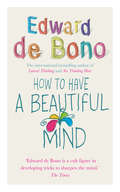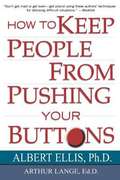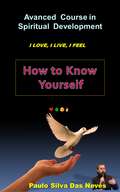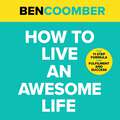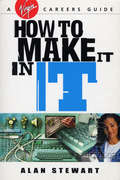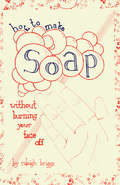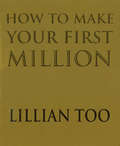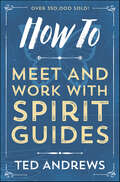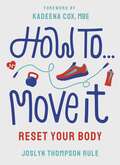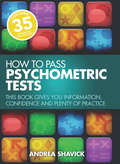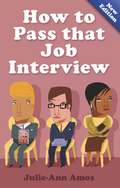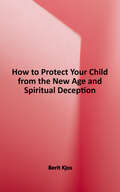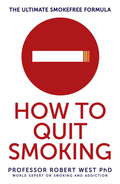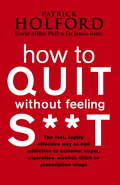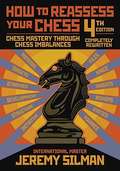- Table View
- List View
How To Grow Fresh Air: 50 Houseplants To Purify Your Home Or Office
by Dr B.C. WolvertonAn illustrated guide to the houseplants you need for clean and fresh air when you're stuck at homeHow clean is the air you breathe? Plants are the lungs of the earth: they produce the oxygen that makes life possible, add precious moisture and filter toxins. Houseplants can perform these essential functions in your home or office with the same efficiency as a rainforest in our biosphere. In this beautifully illustrated guide, noted scientist Dr Bill Wolverton shows you how to grow 50 plants that filter the most common pollutants, making it easy for you to purify the environments that impact you the most.
How To Have A Beautiful Mind
by Edward de BonoPeople spend a fortune on their bodies, their faces, their hair, their clothes. Cosmetics, plastic surgery, diets, gym membership - everyone's trying to be more attractive. But there's an easier way to become a beautiful person. It doesn't have to be physical. No matter how you look, if you have a mind that's fascinating, creative, exciting - if you're a good thinker - you can be beautiful.And being attractive doesn't necessarily come from being intelligent or highly-educated. It isn't about having a great personality. It's about using your imagination and expanding your creativity. And it's when talking with people that we make the greatest impact. A person may be physically beautiful, but when speaking to others a dull or ugly or uncreative mind will definitely turn them off.In clear, practical language, de Bono shows how by applying lateral and parallel thinking skills to your conversation you can improve your mind. By learning how to listen, make a point, and manoeuvre a discussion, you can become creative and more appealing - more beautiful.
How To Have That Difficult Conversation You've Been Avoiding: With Your Spouse, Adult Child, Boss, Coworker, Best Friend, Parent, Or Someone You're Dating
by John D. Townsend Henry CloudAll of Us need to be able to have a healthy confrontational conversation at one time or another. Sometimes it's a matter of simply saying no so we don't get overextended, or saying yes to better ways of building intimacy in a good relationship. At other times, we may need to confront a difficult person in a relationship-a controller, a manipulator, an irresponsible person, perhaps even someone who is abusive.
How To Keep People From Pushing Your Buttons
by Albert Ellis Arthur LangePresents proven strategies for not reacting to antagonists, revealing a third path between getting mad and getting even, and offers advice on how to stop worrying about what people think, avoiding difficult situations and responsibilities, trying to please everyone, and more.
How To Know Yourself
by Paulo Silva Das NevesThe book has a structured, close and appropriate language for a self-help book. It also has a foreword by the renowned journalist Isabel de la Fuente. The book of my life is a work of emotional self-help, which does not speak of the life of the author of the book, but of the life of the reader. A book that talks about the life of the reader? Yes, how is that? The book asks you questions and gives you the answers, because everything is within you and you know your life better than anyone. This book interacts with you and becomes your life partner. It gives you self-help tools for you to understand and change your life. It invites you to reflect on the life you lead, improve it and recover your life giving it a deep meaning. unique in his life with values, true will, clairvoyance, vocation ... A path to victory and fulfillment. This book will help you predict your future, it will teach you how to open paths, cleanse energy, elevate souls, heal your soul, there is a complete culture and community about this book and your way of life.
How To Live An Awesome Life: The 11 Step Formula for Fulfilment and Success
by Ben CoomberTake a moment to consider what you want for your future. What do you want your body to look and feel like? What career do you want? What experiences do you dream of conquering?Living a life of passion, purpose and fulfilment, on your own terms, in your own way, is the key to happiness - so why are you waiting around and not taking bold action? Why hide behind upbeat selfies, making excuses instead of following your dreams? If your life isn't inspiring you, it's time to change.In 11 inspiring, actionable steps, this book will help you set BIG achievable goals that shape the life you want to live. You'll discover how to be fitter, happier and more successful, to live with vitality and zest for all that's in your life, and to ultimately live a life of fulfilment, accomplishing all your dream of, with zero regrets. Life success isn't a secret. It's a blueprint. And it's in this book. Your AWESOME future is waiting.
How To Live An Awesome Life: The 11 Step Formula for Fulfilment and Success
by Ben CoomberTake a moment to consider what you want for your future. What do you want your body to look and feel like? What career do you want? What experiences do you dream of conquering?Living a life of passion, purpose and fulfilment, on your own terms, in your own way, is the key to happiness - so why are you waiting around and not taking bold action? Why hide behind upbeat selfies, making excuses instead of following your dreams? If your life isn't inspiring you, it's time to change.In 11 inspiring, actionable steps, this book will help you set BIG achievable goals that shape the life you want to live. You'll discover how to be fitter, happier and more successful, to live with vitality and zest for all that's in your life, and to ultimately live a life of fulfilment, accomplishing all your dream of, with zero regrets. Life success isn't a secret. It's a blueprint. And it's in this book. Your AWESOME future is waiting.
How To Live An Awesome Life: The 11 Step Formula for Fulfilment and Success
by Ben CoomberIt's time to go big - this audiobook will help you visualise your life at its most awesome and show you exactly how to get there. BIG change is possible!Take a moment to consider what you want for your future. What do you want your body to look and feel like? What career do you want? What experiences do you dream of conquering?Living a life of passion, purpose and fulfilment, on your own terms, in your own way, is the key to happiness - so why are you waiting around and not taking bold action? Why hide behind upbeat selfies, making excuses instead of following your dreams? If your life isn't inspiring you, it's time to change.In 11 inspiring, actionable steps, this audiobook will help you set BIG achievable goals that shape the life you want to live. You'll discover how to be fitter, happier and more successful, to live with vitality and zest for all that's in your life, and to ultimately live a life of fulfilment, accomplishing all your dream of, with zero regrets. Life success isn't a secret. It's a blueprint. And it's in this audiobook. Your AWESOME future is waiting.(P) 2023 Hodder & Stoughton Limited
How To Love A Difficult Man
by Nancy GoodThis book talks about common relationship problems that women experience in a warm, engaging style. This isn't a book about bashing men or demanding your rights. Rather, it's a book about asking for what women want and need in a clear, positive way. It advises women to know their own value as a person and to handle these issues with respect and dignity.
How To Make It In IT
by Alan StewartComputers have been in daily use at work for nearly half a century. Each new generation of the technology – mainframes, mini-computers, Cs and the Internet – has brought a demand for a fresh set of skills, but there are never enough people to fill the ever-growing number of posts in the IT sector. This guarantees that there is stiff competition among employers for the best technicians, which means that salaries can be very high.The overall picture might be rosy, but if you want an honest evaluation of the different areas and jobs on offer, you need this book. Have you got the intellectual stamina to be a security analyst? What qualities and skills are employers looking for in their technical authors and operations managers? And how can you freelance successfully as a programmer or consultant? Based on interviews with people at all levels of the industry, this informed, no-nonsense guide points you to the right job – and shows you how to get it.Whether you want to be the next Bill Gates or would be quite happy in a secure job with a blue-chip company, your IT career starts here.
How To Make Soap: Without Burning Your Face Off
by Raleigh BriggsRaleigh Briggs, author of the popular Microcosm title Make Your Place, is back with another pamphlet on better, healthier living. This time around, she tackles soap-making basics, and teaches us how to create silky handmade soaps at home.<P><P> How To Make Soap contains basic directions, recipes, a list of resources, and assorted tips and tricks to make your homemade soaps special. Raleigh takes a seemingly arduous task, and makes it breezy and fun, with her charming hand-drawn illustrations and easy to follow directions. How to Make Soap is a great guide (and gift!) for the beginning soapmaker, looking for a place to start.<P><P> Advisory: Bookshare has learned that this book offers only partial accessibility. We have kept it in the collection because it is useful for some of our members. To explore further access options with us, please contact us through the Book Quality link on the right sidebar. Benetech is actively working on projects to improve accessibility issues such as these.
How To Make Your First Million
by Lillian TooIn HOW TO MAKE YOUR FIRST MILLION, Lillian Too combines her canny understanding of the business world, her knowledge of personal financial management and her expertise with feng shui to show you how to become rich beyond your wildest dreams. In simple, accessible terms, she explains the importance of planning, focussed thinking, a positive attitude and harnessing the powers of luck in order to pave your way to prosperity.
How To Manage Your Mother: Understanding The Most Difficult, Complicated, And Fascinating Relationship In Your Life
by Alyce Faye Cleese Brian BatesGuilt. Embarrassment. Friendship. Anger. Who can bring out all these feelings ... and often in the same day? Your mother. No matter how mature or successful we are in our adult lives, with one word our mothers can somehow send us scurrying back to childhood. Can mothers and adult children ever learn to set aside their earlier elationship and talk to each other as adults? In this warm, funny book, dozens of revealing stories from such well-known personalities as Colin Powell, Helena Bonham Carter, Mia Farrow, and Lauren Hutton show that it is possible to improve your relationship with your mother-or at the very least begin to understand it. Alyce Faye Cleese and Brian Bates include a practical ten-step plan and questionnaire to help you get on track with your mother. You will learn to address specific issues and develop valuable insights that will help you start thinking about your mother in a profoundly new way.
How To Meditate: A Practical Guide to Making Friends with Your Mind
by Pema Chödrön***How to Meditate Has Been Named One of Library Journal’s Best Books of 2013*** <p> <p> Pema Chodron is treasured around the world for her unique ability to transmit teachings and practices that bring peace, understanding, and compassion into our lives. With How to Meditate, the American-born Tibetan nun presents her first book exploring in depth what she considers the essentials for a lifelong practice. <p> When we look for a meditation teacher, we want someone who has an intimate knowledge of the path. That's why so many have turned to Pema Chödrön, whose gentle yet straightforward guidance has been a lifesaver for both first-time and experienced meditators. With How to Meditate, the American-born Tibetan Buddhist nun presents her first book that explores in-depth what she considers the essentials for an evolving practice that helps you live in a wholehearted way. <p> More and more people are beginning to recognize a profound inner longing for authenticity, connection, compassion, and aliveness. Meditation, Pema explains, gives us a golden key to address this yearning. This comprehensive guide shows readers how to honestly meet and openly relate with the mind to embrace the fullness of our experience as we discover: <p> •The basics of meditation, from getting settled and the six points of posture to working with your breath and cultivating an attitude of unconditional friendliness<br> •The Seven Delights-how moments of diffi culty can become doorways to awakening and love<br> •Shamatha (or calm abiding), the art of stabilizing the mind to remain present with whatever arises<br> •Thoughts and emotions as "sheer delight"-instead of obstacles-in meditation <p> Here is in indispensable book from the meditation teacher who remains a first choice for students the world over. <p> “Pema is one of our most beloved and helpful teachers—practical, compassionate, and wise. How to Meditate is a great way to take her teachings to heart and develop a meditation practice.” —Jack Kornfield, author of A Path with Heart and A Lamp in the Darkness <p> “This new book is a great compilation of meditation instruction which she has personal given to many of her students over the years. These instructions have brought so much help to others that it has made her one of the most loved and revered Buddhist teacher in this modern world. With a brilliant mind and an absolutely cheerful attitude toward life, she practices what she teaches. She is a great support and friend to thousands of readers, and I am very sure that this book will help many in their everyday lives, as she makes this genuine attempt to reach us all.” —Dzigar Kongtrul Rinpoche
How To Meet and Work with Spirit Guides
by Ted AndrewsEach of us can benefit from contact with the spiritual realm, and we often do so without realizing it. Spirit guides serve many roles and take many forms of expression within our lives. They inspire creativity and insight, help open us to abundance, protect us, and serve as our companions.In How To Meet and Work with Spirit Guides, popular author Ted Andrews teaches you simple and effective techniques for establishing rapport with your angels and guides. Explore meditation, divination, fragrance, crystals, and other ways to connect with spirit helpers, and enjoy the many gifts and learning opportunities gained by working with:Guardian angelsSpirit guidesLoved ones in spiritAnimal totemsNature spiritsFairies
How To Move It: Reset Your Body (Merky How To #5)
by Joslyn Thompson RuleIntroducing the new 'How To...' series from #Merky Books: unlock your potential with our short, practical pocket-sized guides._______________________________________________________How to Move It: Reset Your BodyThis book is about motivating your body through the power of movement, focusing on you as an individual and not the ideal of fitness we see so often. Before you lift a single kettle bell or hit the yoga mat, Nike Master Trainer Joslyn Thompson Rule will break down the stages to moving your body for the better. Starting with your brain, then your breathing and finally your body. Packed full with motivational and practical exercises for mobility, strength, conditioning, and recovery. This book is a personal trainer in your pocket, encouraging you along the way and helping you to have a healthy relationship with fitness.Written by Joslyn Thompson RuleForeword by Kadeena Cox, MBE_______________________________________________________Designed to inspire and encourage readers to unlock their potential and provoke change, the How To series offers a new model in publishing, helping to break down knowledge barriers and uplift the next generation.Creatively presented and packed with clear, step-by-step, practical advice, this series is essential reading for anyone seeking guidance to thrive in the modern world. Curate your bookshelf with these collectible titles.
How To Pass Psychometric Tests: This Book Gives You Information, Confidence And Plenty Of Practice
by Andrea ShavickIn this book, author Andrea Shavick explains all there is to know about psychometric tests: what they are, what they measure, who uses them, why they're used, how they're changing, how to survive them, and even how to avoid them altogether! It includes 35 different, genuine, practice test from SHL Group pls, the world's biggest test publisher. It has 265 questions covering verbal, numerical, abstract and spatial reasoning; mechanical comprehension; fault diagnosis; acutness and personlaity. This book gives you the information, confidence and practice to pass psychometric tests.
How To Pass Psychometric Tests: This book gives you information, confidence and plenty of practice
by Andrea ShavickIn this book, author Andrea Shavick explains all there is to know about psychometric tests: what they are, what they measure, who uses them, why they're used, how they're changing, how to survive them, and even how to avoid them altogether! It includes 35 different, genuine, practice test from SHL Group pls, the world's biggest test publisher. It has 265 questions covering verbal, numerical, abstract and spatial reasoning; mechanical comprehension; fault diagnosis; acutness and personlaity. This book gives you the information, confidence and practice to pass psychometric tests.
How To Pass That Job Interview 5th Edition
by Julie-Ann AmosNow in its 5th edition, this book includes: The latest trends and expectations from employers in an ever-changing marketplace. Specific advice for beginners from an industry expert. Updated information on how the world of interviews works, and what employers hate most.
How To Pass That Job Interview 5th Edition
by Julie-Ann AmosNow in its 5th edition, this book includes: The latest trends and expectations from employers in an ever-changing marketplace. Specific advice for beginners from an industry expert. Updated information on how the world of interviews works, and what employers hate most.
How To Practice: The Way To A Meaningful Life
by Dalai Lama Xiv Jeffrey HopkinsAs human beings, we possess one common desire: the need for happiness and a meaningful life. According to His Holiness the Dalai Lama, the ability to find true fulfillment lies within each of us. Now, the spiritual and temporal leader of Tibet, Nobel Prize winner, and bestselling author helps readers begin the path to enlightenment in a very special book -- an easy-access reference for daily practice as well as stunning illumination of the timeless wisdom of His Holiness. How to Practicewill guide you toward opening your heart, refraining from doing harm, maintaining mental tranquility, and more. Divided into a series of distinct steps that will lead spiritual seekers of all faiths toward enlightenment, this accessible book is a constant and daily companion in the quest to practice morality, meditation, and wisdom. The Dalai Lama shows us how to overcome our everyday obstacles, from feelings of anger and mistrust to jealousy, insecurity, and counterproductive thinking. Imbued with His Holiness' vivacious spirit and sense of playfulness,How to Practiceoffers the Dalai Lama's own sage and very practical insight into the human psyche and what binds us all together.
How To Protect Your Child from the New Age and Spiritual Deception
by Berit KjosTempting Voices Beckon to children everywhere. Schools, movies, music, and books all sound the call: "Come, dream, trust Self, you are divine, create your own reality, build a new world. Anything goes, for sin and guilt exist only in the minds of the antiquated 'religious.'" "Unlearning the old ways" is key to this global transformation. Today's assault on biblical Christianity is fast undermining God's moral and spiritual boundaries. It invites chaos rather than unity - coercion instead of freedom - war and violence instead of peace - and ultimately overtakes today's children with the plan to turn them into "progressive" transformation leaders of tomorrow. How can we equip our children so they do not become spiritually deceived and fall into this worldwide agenda? And how can we teach them to have the courage to say no to seductive enticements? There is an answer! We can teach our children to know Truth, so they will discern the counterfeit. And we can teach them how to spot the New Age/New Spirituality and to understand the serious implications that occur when it is embraced.
How To Quit Smoking: The Ultimate SmokeFree Formula
by Professor Robert WestThe truth about quitting smoking and how it can work for you.YOU CAN STOP SMOKING FOR GOOD.How to Quit Smoking reveals the TRUTH about stopping smoking from leading expert Professor Robert West.This book shows, for the first time, how you can create your personal SmokeFree Formula so that you are free from cigarettes for good.Professor Robert West is a world authority on smoking and addiction and has been helping smokers stop for more than 30 years. He is an advisor to the Department of Health and helped set up the NHS Stop SmokingServices. The book was written with Chris Smyth, Health Correspondent at The Times, and Jamie West.How to Quit Smoking is the ultimate guide to stopping smoking once and for all.
How To Quit Without Feeling S**T: The fast, highly effective way to end addiction to caffeine, sugar, cigarettes, alcohol, illicit or prescription drugs
by David Miller Patrick Holford James BralyThis groundbreaking book from the UK's leading spokesman on nutrition looks at why millions of people have cravings for substances such as coffee, sugar and alcohol, as well to drugs such as sleeping pills, antidepressants, marijuana and cocaine. It uncovers how the brain becomes addicted and how it can be 'unaddicted' through a combination of diet, supplements and lifestyle factors. The book is written in association with Dr David Miller, who has worked in the addiction field for 25 years and is an expert in relapse prevention. It looks at each of the most common substances that people become addicted to and offers specific advice on how to tackle that particular substance safely and effectively yourself. In-depth yet practical and accessible, HOW TO QUIT WITHOUT FEELING S**T, will allow you to understand why you feel the way you do, whether you have a depndency or have already given up but still feel lousy. The book provides a 12-week action plan for becoming addiction free - without suffering the deeply unpleasant symptoms of withdrawal that most addicts believe they must go through
How To Reassess Your Chess: Chess Mastery Through Chess Imbalances
by Jeremy SilmanHow to Reassess Your Chess has long been considered a modern classic. This fourth and final edition completely rewritten and featuring all new examples takes Silman's groundbreaking concept of imbalances to a whole new level. Designed for players in the 1400 to 2100 rating range and for teachers looking for a ready-made chess curriculum, the author shares a mind-expanding journey that takes the reader through imbalance-basics, ensures that every detail of all the imbalances are mastered, and leaves the player/lover of chess with something he always wanted but never believed he could achieve: a master-level positional foundation. <P><P>A section on practical chess psychology (titled Psychological Meanderings) presents never-before-published ideas on psychological processes that hinder players of all levels, and gives easy-to-follow advice and techniques that will help anyone overcome these ubiquitous mental/emotional failings. <P><P>Hundreds of games brought to life by instruction-rich prose, and stories that offer humor while highlighting various lessons, vividly illustrate all the book's topics in a manner that's both personal and fun. <P><P>If the positional masterpieces of the chess legends have always been a mystery to you, if chess strategy has always been an unsolvable enigma, if you find yourself a positional pawn rather than a positional master, then How to Reassess Your Chess, 4th edition will prove to be a life-changing experience. <P><P>Jeremy Silman is an International Master and a world-class teacher, writer, and player who has won the American Open, the National Open, and the U.S. Open. Considered by many to be the game's preeminent instructive writer, he is the author of over thirty-seven books, including Silman's Complete Endgame Course, The Amateur's Mind, The Complete Book of Chess Strategy, and The Reassess Your Chess Workbook. His website (www.jeremysilman.com) offers fans of the game instruction, book reviews, theoretical articles, and details

